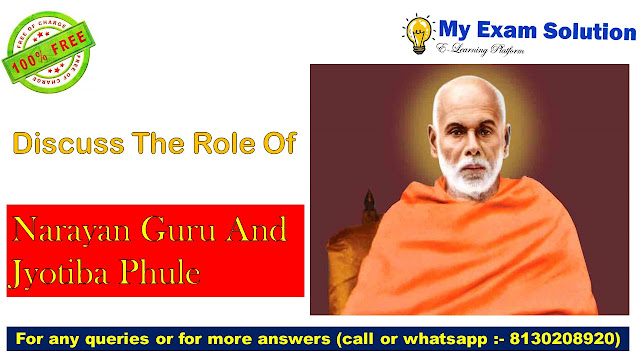Discuss the role of Narayan Guru and Jyotiba Phule in the development of the idea of equality
Narayan Guru and Jyotiba Phule were two social reformers who
played a crucial role in the development of the idea of equality in India. Here
is a brief discussion of their contributions:
- Narayan Guru: Narayan Guru was a spiritual leader and social reformer who lived in the late 19th and early 20th centuries. He was born into a lower-caste family and faced discrimination and social exclusion throughout his life. Narayan Guru was a proponent of the idea of Advaita (non-dualism), which emphasized the essential oneness of all beings.
Narayan Guru believed that all individuals, regardless of
their caste, gender, or religion, were equal and should be treated with dignity
and respect. He founded a number of institutions that aimed to promote equality
and social justice, such as schools, ashrams, and temples that were open to all
castes and communities. He also worked to promote interfaith harmony and peace,
and was known for his efforts to bridge the gap between different religious
groups in India.
- Jyotiba Phule: Jyotiba Phule was another social reformer who lived in the 19th century. He was born into a lower-caste family and faced discrimination and social exclusion throughout his life. Phule was a staunch critic of the caste system and the oppression of lower-caste communities.
Phule believed that education was the key to empowering
marginalized communities and promoting equality. He founded a number of schools
and colleges for Dalits and other lower-caste groups, and also worked to
promote women's education and empowerment. Phule was a strong advocate for
social reform and worked to challenge traditional hierarchies and power
structures that perpetuated inequality.
Overall, Narayan Guru and Jyotiba Phule played a crucial role
in promoting the idea of equality in India. Their contributions helped to raise
awareness about the need for social reform and to lay the groundwork for future
efforts to promote equality and social justice.
Fight against casteism
Casteism was rehearsed in Kerala during the nineteenth and
mid twentieth hundreds of years and the lower standing individuals, for
example, Ezhavas and the distant ranks like Paraiyars, tribals and Pulayars
needed to experience the ill effects of the upper position local area It was
against this separation that Master played out his most memorable significant
public demonstration, the sanctification of Siva symbol at Aruvippuram in 1888.
In general, he blessed 45 sanctuaries across Kerala and Tamil Nadu.. His
sanctifications were not really customary divinities; a piece recorded with the
words, Truth, Morals, Empathy, Love a vegan Shiva, a mirror and a figure by an
Italian stone carver were among the different sanctifications made by him. He
spread the beliefs of empathy and strict resistance and one of his prominent
works, Anukampadasakam, praises different strict figures like Krishna, The
Buddha, Adi Shankara, Jesus Christ.
Vaikom Satyagraha
The social dissent of Vaikom Satyagraha was a fomentation by
the lower standing against distance in Hindu society of Travancore.
It was accounted for that the trigger for the dissent was an
episode when Narayana Master was halted from going through a street prompting
Vaikom Sanctuary by an upper standing individual. It provoked Kumaran Asan and
Muloor S.Padmanabha Panicker, the two pupils of Master, to make sonnets in
fight out of the episode. T. K. Madhavan, another supporter, appealed to the
Sree Moolam Well known Gathering in 1918 for rights to enter the sanctuary and
love, no matter what the standing. A large group of individuals including K.
Kelappan and K. P. Kesava Menon, shaped a board of trustees and declared Kerala
Paryatanam development and with the backing of Mahatma Gandhi, the tumult
formed into a mass development which brought about the kickoff of the sanctuary
as well as three streets prompting it to individuals, everything being equal.
Sivagiri journey
Sivagiri journey was brought about by three of the supporters
of Master viz. Vallabhasseri Govindan Vaidyar, T. K. Kittan Essayist and Muloor
S. Padmanabha Panicker which Master supported in 1928, with his own
suggestions. He proposed that the objectives of the journey ought to be the
advancement of instruction, neatness, commitment to God, association, farming,
exchange, crafted works, and specialized preparing and encouraged Vaidyar and
Essayist to coordinate a progression of talks on these subjects to pressure the
requirement for the act of these goals, expressing this to be the center reason
for Sivagiri journey. Be that as it may, his demise not long after deferred the
task until 1932 when the principal journey was embraced from Elavumthitta in
Pathanamthitta Area
Works and reasoning
Master distributed 45 works in Malayalam, Sanskrit and Tamil
dialects which incorporate Atmopadesa Śatakam, 100 section profound sonnet and
Daiva Dasakam, a widespread supplication in ten refrains. He likewise
interpreted three significant texts, Thirukural of Valluvar, Ishavasya
Upanishad and Ozhivil Odukkam of Kannudaiya Vallalaar. It was he who engendered
the witticism, One Station, One Religion, One God for All (Oru Jathi, Oru
Matham, Oru Daivam, Manushyanu) which has become well known as an expression in
Kerala. He promoted the non-dualistic way of thinking of Adi Sankara by
bringing it into training by adding the ideas of social equity and all
inclusive fraternity.
ALSO READ:-
- The trends of agricultural growth in India since Independence
- Write a note on the Ambedkar’s idea of Annihilation of Caste
- Write an essay on the relation between Spirituality
Whatsapp :- 8130208920
Youtube :- Myexamsolution







0 comments:
Note: Only a member of this blog may post a comment.